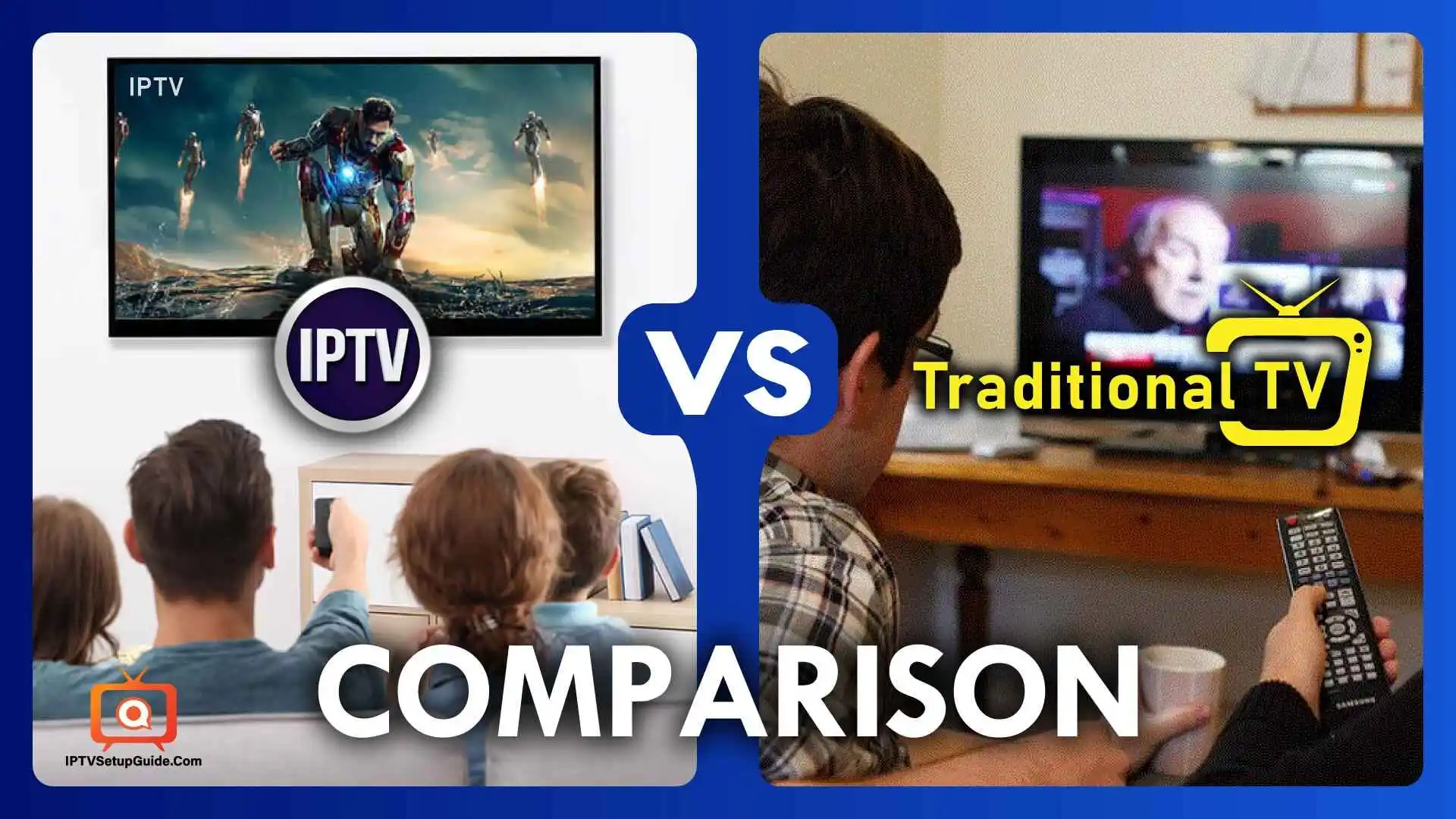Cutting the cord? Unsure if IPTV or traditional TV reigns supreme? This guide dissects the two titans of television, weighing their strengths and weaknesses to help you choose the champion for your living room.
Understanding IPTV:
IPTV, or Internet Protocol Television, ditches cables, and broadcasts live TV channels directly through your internet connection. Think of it as Netflix meets live news, sports, and your favorite sitcoms, all streamed seamlessly to your devices.
The Basics of Traditional TV:
The OG of television, traditional TV delivers channels through cable, satellite, or terrestrial antennas. Familiar setup boxes and channel surfing define the experience, providing a reliable (if sometimes limited) viewing ecosystem.
Comparing IPTV vs Traditional TV:
Content Variety and Accessibility:
- IPTV: Boasts a wider range of channels, including international options, niche networks, and on-demand content libraries. Access it on any device with a strong internet connection, making it perfect for cord-cutters and mobile viewers.
- Traditional TV: Offers primarily local and nationally recognized channels. Accessibility depends on your package and location, limiting options for those seeking diverse or niche content.
Cost Considerations:
- IPTV: Subscription fees often start lower than cable packages, but costs can add up with premium channels and add-ons. Internet bandwidth requirements may also factor in.
- Traditional TV: Contract obligations and bundled packages can lead to hidden costs. Equipment rental fees and additional service charges can inflate your monthly bill.
Picture and Sound Quality:
- IPTV: This can deliver exceptional picture quality with HD and even 4K resolutions, depending on your internet speed and provider. However, buffering and pixelation can occur with a weak connection.
- Traditional TV: Picture quality varies depending on your package and provider. Signal strength and interference can impact clarity, especially with older cable or satellite technologies.
User Interface and Features:
- IPTV: Modern IPTV platforms offer user-friendly interfaces with personalized recommendations, search functionalities, and interactive features like recording and pause/rewinding.
- Traditional TV: Interfaces tend to be less intuitive, often limited to basic channel guides and on-demand options. Interactive features are typically confined to higher-tier packages.
Device Compatibility:
IPTV: Highly versatile, accessible on most devices with internet access, including smart TVs, smartphones, tablets, computers, and even gaming consoles. Dedicated apps and web interfaces provide seamless streaming across platforms.
Traditional TV: Primarily limited to televisions and set-top boxes provided by the service provider. Streaming options for mobile devices and computers might be limited or require additional equipment and subscriptions.
Reliability & Troubleshooting:
IPTV: While highly reliable with strong internet connections, buffering, and pixelation can occur during peak network usage or with weak bandwidth. Investing in a stable internet plan and choosing reputable providers can mitigate these issues. Troubleshooting often involves checking internet speed, restarting devices, and ensuring proper software updates.
Traditional TV: Generally reliable when signal strength is strong. Cable outages and interference can disrupt viewing, especially in remote areas or during harsh weather. Troubleshooting typically involves contacting your provider, checking cable connections, and ensuring equipment is functioning properly.
Additional Features of IPTV and Traditional TV:
IPTV: Many IPTV providers offer advanced features like:
- Multi-screen viewing: Watch on multiple devices simultaneously.
- Parental controls: Manage age-restricted content for children.
- Catch-up TV: Rewind and rewatch recently aired programs.
- Personal recommendations: Curated suggestions based on viewing habits.
- Cloud DVR: Record shows and store them remotely for later viewing.
Traditional TV: Some providers offer limited interactive features like:
- On-demand content libraries: Rent movies and TV shows.
- Sports packages: Access dedicated sports channels.
- Interactive guides: Search for content and access program information.
Future of Television:
IPTV: Poised to dominate with its flexibility, content variety, and personalization potential. Emerging technologies like cloud-based platforms and AI-powered recommendations will further enhance the experience.
Traditional TV: May adapt by offering hybrid packages combining IPTV features with existing cable or satellite infrastructure. Focus on premium content and niche channels could remain relevant for specific audiences.
Ultimately, the future of television lies in offering viewers customized viewing experiences with seamless access to their preferred content regardless of device or location. Both IPTV and traditional TV have roles to play in this evolving landscape, with the winner being the one that best adapts to the ever-changing demands of audiences.
Frequently Asked Questions:
IPTV has the potential for superior quality, but internet speed and provider infrastructure play a significant role.
Yes, many smart TVs and devices offer dedicated IPTV apps.
While facing competition, traditional TV still caters to specific needs and offers reliable, familiar viewing experiences.
Conclusion:
The choice between IPTV and traditional TV comes down to your priorities. If you crave flexibility, content variety, and cutting-edge features, IPTV might be the champion. For those who value familiar interfaces, lower upfront costs, and reliable signal strength, traditional TV might still hold the crown. Ultimately, the winner is you, armed with the knowledge to choose the TV experience that best suits your needs and lifestyle.
